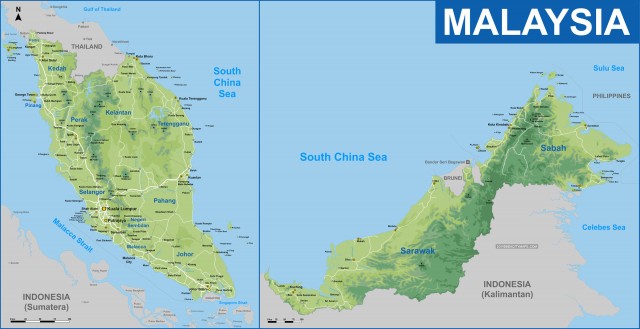Malaysia
Area 127,316 square mi (329,750 square km)
Population 29.90 million 2014
Capital Kuala Lumpur
Highest Point 13,450 ft (4,100 m)
Lowest Point 0 m
GDP $326.9 billion 2014
Primary Natural Resources tin, petroleum, timber, copper, iron ore.
MALAYSIA IS LOCATED in the heart of Southeast Asia and is divided into two geographical sections: Peninsular Malaysia and the East Malaysian provinces of Sabah and Sarawak, which are located in northern BORNEO, some 403 mi (650 km) across the South China Sea. Malaysia's peninsular neighbors are THAILAND to the north and the island country of SINGAPORE in the south. The Andaman Sea and the MALACCA Straits are on the west coast of Peninsular Malaysia, while the South China Sea borders both the east coast of Peninsular Malaysia and the East Malaysian provinces of Sabah and Sarawak. Sabah and Sarawak border Kalimantan (the Indonesian part of Borneo) and Sarawak surrounds the tiny enclave of BRUNEI. Because of Malaysia's location on a peninsula, it has 2,900 mi (4,675 km) of coastline.

GEOGRAPHY
Peninsular Malaysia's 50,580 square mi (131,000 square km) accounts for 40 percent of the country's landmass. There are several mountain ranges running north to south along the backbone of the peninsula, and a narrow causeway that connects it with Singapore to the south. A wide, fertile plain extends along the West Coast next to the Malacca Straits, while a narrow coastal plain runs along the east coast next to the South China Sea.
East Malaysia (76,458 square mi or 198,000 square km) lies east of Peninsular Malaysia across the South China Sea and occupies a broad strip running from the westernmost to the northernmost tip of the island of Borneo. Dense jungles and tropical RAINFORESTs cover East Malaysia. Because of the rugged conditions, most of the local natives use the large river networks as the main means of transportation.
Malaysia is hot and humid all year round and over 60 percent of the country is considered to be rainforest. The east coast of Peninsular Malaysia has a distinct rainy season because of the monsoon climate. The wettest season on the west coast of the peninsula is between September and December, while on the east coast and in Sabah and Sarawak, the rainy season comes between October and February. The rains often come in short, strong bursts where the water seems to come straight down as if being poured out of a bucket. When they just as quickly disappear, the humidity level soars and you wish for another rain.
PEOPLE
As the economy develops, Malaysia is becoming more and more urban, with cities accounting for 40 percent of the total population. The principal urban concentration is in the Klang Valley, around the capital city of Kuala Lumpur (1.4 million), where the population has been growing annually at a rate of 7 percent. Peninsular Malaysia is also more heavily populated than East Malaysia with nearly 85 percent of the country's total population. Malaysia is also a very young country, with 38 percent of the total population under the age of 15 and only 4 percent over the age of 65. Malays and other indigenous ethnic groups (together known as Bumiputras) account for 59 percent of the population, the Chinese 24 percent and Indians 8 percent. The official language is Bahasa Malaysia (Malay), but English still predominates in industry and commerce. The official religion of the country is Islam, but there is freedom of worship.
ECONOMY
Malaysia has historically been an exporter of primary products such as rubber, tin, palm oil, and timber. Malaysia has long been an important exporter of palm oil (50 percent of world production), generating exports of about $2 billion annually. In the mid-1970s export manufacturing, in particular of textiles and electronics, began to develop, based on an accommodative government attitude toward incoming foreign investment and a skilled low-cost labor force. As a result, Malaysia has become one of the world's three largest manufacturers of semiconductors and air conditioners. Malaysia's economy has enjoyed very positive real annual growth during the last decade, with the manufacturing sector contributing more than 40 percent of the total growth, and the finance, agriculture, and transport sectors each contributing about 10 percent. Malaysia is often cited as one of the Asian Tigers because of its relatively high gross domestic product per capita. The key industries in Peninsular Malaysia include rubber and oil palm processing and manufacturing, light manufacturing industry, electronics, tin mining and smelting, and logging and processing timber. Sabah in East Malaysia is known for its logging and petroleum production, while agricultural processing, petroleum production and refining, and logging are done in Sarawak.
HISTORY
Because of the Malacca Straits, which provide an inside passage from the South China Sea to INDIA, Malaysia has been a strategic factor in trade for thousands of years. From the 900s on, there were numerous Chinese and other settlements established to support the great sailing fleets moving goods between Asia, India, and the MIDDLE EAST. With the formation of the Dutch East India Company, the region became a stronghold for Europeans trying to protect their interests in the highly profitable spice trade and ultimately led to the founding of SINGAPORE. In 1957, the Federation of Malaya, comprising the 11 states of Peninsular Malaysia, gained independence from the UNITED KINGDOM. The federation became known as Malaysia with the accession of three further states, Singapore, Sarawak, and Sabah, in 1963. In August 1965, Singapore withdrew from the federation to become an independent sovereign state. Malaysia is a federal constitutional monarchy. Its head of state is the king, who is elected for a five-year term by the nine hereditary sultans of the eleven states of Peninsular Malaysia.